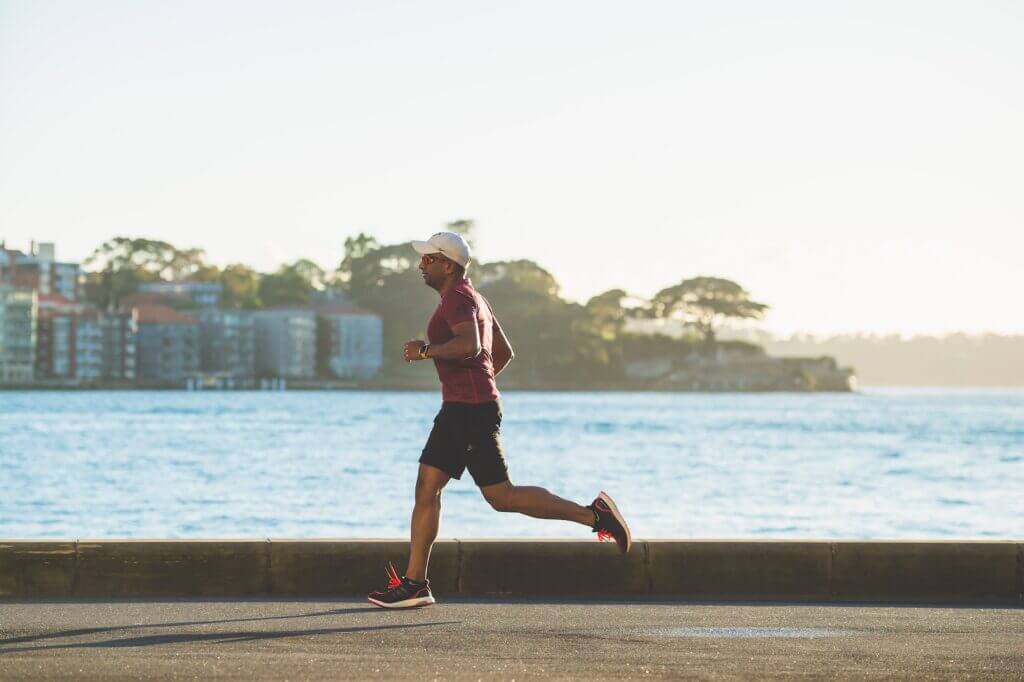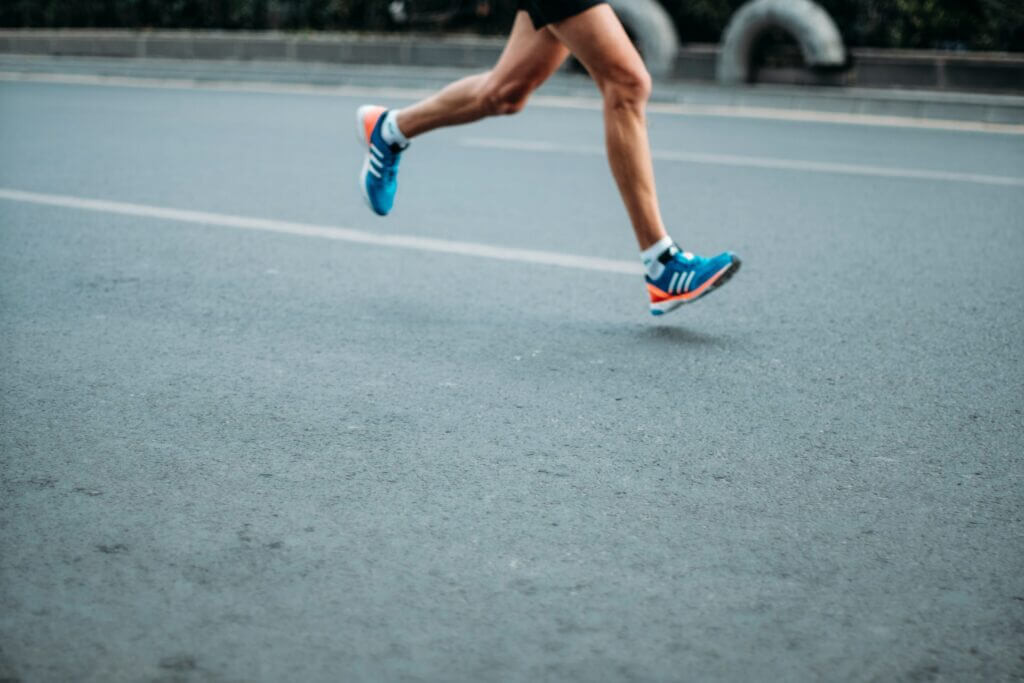Are you looking to improve your running performance and reduce your risk of injuries? Look no further than the midfoot strike, the running technique that could change the way you run forever.
Proper foot strike is crucial for runners, and a midfoot strike has become increasingly popular in recent years due to its many benefits. In this blog post, we’ll explore the mechanics of midfoot strike, its benefits, and how to transition to this technique for optimal results.
Get ready to discover how midfoot strike can transform your running game and leave you feeling confident and powerful!
Table of Contents
Understanding Midfoot Strike

A. What is a midfoot strike
A midfoot strike is a running technique where the foot lands flat on the ground with the midfoot striking the ground first. In contrast to the heel strike, where the heel hits the ground first, and forefoot strike, where the ball of the foot lands first, the midfoot strike is considered to be the optimal foot strike pattern for runners.
When you land on the midfoot, your weight is evenly distributed across your foot, reducing the impact on your joints. This can help prevent injuries such as shin splints and stress fractures. In addition, midfoot strike allows for better energy transfer, which can improve running efficiency and speed.
B. Comparison with heel and forefoot strike
The heel strike is the most common foot strike pattern among runners. When the heel strikes the ground first, it creates a braking effect, which can increase the impact on your joints and slow you down. A heel strike is also associated with overstriding, which can lead to injuries.
Forefoot strike, on the other hand, involves landing on the ball of your foot first. This foot strike pattern is commonly associated with sprinters and is often used in barefoot running. While forefoot strike can reduce the impact on joints, it can also cause calf and foot muscle fatigue.
C. How to determine your foot strike pattern
Determining your foot strike pattern is essential to understand whether you need to make adjustments to your running technique. One way to determine your foot strike pattern is to examine the wear pattern on your running shoes. If you notice more wear on the heel of your shoe, it’s likely that you have a heel strike pattern. If you see more wear on the ball of your foot, you may have a forefoot strike pattern.
Another way to determine your foot strike pattern is to observe yourself running on a treadmill or have someone record you. Look at where your foot lands first and compare it with the three-foot strike patterns discussed. If you’re unsure or would like a more accurate analysis, you can also consult with a running coach or podiatrist.
Understanding your foot strike pattern is the first step towards transitioning to a midfoot strike pattern, which can help improve your running efficiency and reduce your risk of injury.
5 Benefits of Midfoot Strike
A proper foot strike is essential for efficient and injury-free running. A midfoot strike is one of the three primary foot strike patterns, alongside heel and forefoot strikes. While heel strike is the most common foot strike pattern, studies have shown that midfoot strike is the optimal foot strike pattern for runners, providing numerous benefits.
1. Reduced risk of injury

One of the primary benefits of midfoot strikes is that they can significantly reduce the risk of injury while running. Traditional heel striking puts a great deal of stress on the ankles, knees, and hips, as the impact of each stride is absorbed primarily by the heel. This repetitive stress can lead to injuries such as shin splints, stress fractures, and patellar tendinitis.
On the other hand, a midfoot strike involves landing on the ball of the foot or the midfoot, allowing the impact to be distributed more evenly throughout the foot and the lower leg. This reduces the stress on the joints and bones, and can greatly reduce the risk of injury.
In addition, midfoot strikes can also help prevent certain types of injuries. For example, it has been shown to be effective in reducing the risk of plantar fasciitis, which is a common condition among runners that causes pain and discomfort in the heel. By distributing the impact of each stride more evenly, midfoot strikes can help prevent the repeated stress that can lead to plantar fasciitis.
Transitioning to midfoot strike can take time and requires proper technique and training, but the long-term benefits in terms of injury prevention can be well worth it for runners. By reducing the risk of injury, midfoot strikes can help runners stay healthy, train more consistently, and ultimately achieve their running goals.
2. Improved running performance

Improved running performance is one of the main benefits of a midfoot strike when compared to a heel or forefoot strike. Running with a midfoot strike can increase speed and endurance, as well as make running feel easier and more efficient.
Midfoot strike allows for better energy transfer during running because it engages the foot and calf muscles more efficiently. When the midfoot strikes the ground, the foot and calf muscles are engaged to absorb and transfer the energy from the ground into the body, which propels the runner forward.
This energy transfer is more efficient than with a heel or forefoot strike, where some of the energy is absorbed by the joints and bones rather than being transferred into the body.
In addition, a midfoot strike can increase running speed because it allows for a more rapid turnover of steps. Because the foot is landing closer to the body’s center of mass with a midfoot strike, there is less time spent on the ground with each step. This means that the runner can take more steps per minute, leading to a faster pace.
Finally, midfoot strikes can improve endurance by reducing the amount of energy required to run. Because midfoot strike is more efficient, it reduces the amount of energy needed to propel the body forward, which can delay fatigue and increase endurance.
Overall, midfoot strike can improve running performance by making running feel easier and more efficient, increasing speed, and improving endurance.
3. Enhanced running efficiency

When it comes to running, efficiency is key. The more efficiently you can move your body, the less energy you’ll need to expend, and the farther and faster you’ll be able to go. One of the ways that midfoot strike can enhance running efficiency is by optimizing the use of the calf and foot muscles.
When you land on your midfoot instead of your heel, you engage the muscles in your calves and feet more effectively. This allows for greater power transfer through the leg and can reduce the amount of energy required to lift and propel the foot forward. In addition, midfoot strike allows for a smoother transition between strides, which helps to maintain forward momentum.
Midfoot strike also encourages a more natural running gait. When you land on your heel, your foot acts as a brake, slowing you down and requiring more energy to get moving again. By contrast, midfoot strike allows for a more natural rolling motion, with the foot acting as a spring to absorb and release energy with each step.
Finally, midfoot strike can reduce oxygen consumption during running. Since it allows for a more efficient transfer of power through the leg, you’ll require less energy to cover the same distance. This means that you’ll be able to run farther and faster before reaching exhaustion.
Overall, the enhanced running efficiency that comes with midfoot strike can help you to achieve your running goals with less effort and to enjoy a more comfortable and natural running experience.
4. Decreased risk of plantar fasciitis
Plantar fasciitis is a painful condition that results from inflammation of the plantar fascia, a thick band of tissue that runs along the bottom of the foot, connecting the heel to the toes. It is a common condition among runners and is often caused by overuse or repetitive stress on the foot.
One of the benefits of a midfoot strike is that it can reduce the risk of developing plantar fasciitis. This is because the midfoot strike distributes the impact of each step more evenly across the entire foot, rather than concentrating it on the heel or forefoot. By landing on the midfoot, the force of the impact is absorbed more gradually, reducing the strain on the plantar fascia.
Additionally, midfoot strike requires better balance and coordination, which can help runners avoid overpronation or supination, which can put additional strain on the plantar fascia. By landing on the midfoot, runners engage their foot muscles more actively, which can help strengthen the muscles that support the arch of the foot and reduce the risk of plantar fasciitis.
It’s important to note that transitioning to a midfoot strike should be done gradually and with proper form to avoid causing injury or strain to other parts of the foot. Runners who experience foot pain or discomfort should consult with a medical professional to determine the best course of action for their specific needs.
However, for those who are able to transition successfully, midfoot strike can be a powerful tool for reducing the risk of plantar fasciitis and other foot-related injuries.
5. Better balance and stability

When runners switch from a heel strike to a midfoot strike, they typically land more directly under their center of mass. This more centered landing position creates a more stable base and helps the body stay in better balance throughout the running motion.
Additionally, midfoot strike requires greater balance and coordination, as the foot and leg have to absorb and distribute the impact of each step in a more controlled manner. The foot and leg muscles must work together to stabilize the body and maintain proper alignment.
This increased level of control and stability can lead to improved overall running form, reducing the risk of injury and enhancing performance.
Overall, midfoot strike can help runners feel more confident and in control while running, as they develop better balance, coordination, and stability.
Transitioning to Midfoot Strike
If you’ve been running with a heel or forefoot strike pattern, transitioning to a midfoot strike may take some time and effort. It’s important to make the transition gradually, to avoid injuries and ensure your muscles adapt to the new technique. Here are some tips to help you make a smooth transition to a midfoot strike:
A. Importance of Gradual Transition
Switching to a midfoot strike can be a shock to your muscles and joints, so it’s important to start slowly and gradually increase your midfoot strike mileage over time.
It’s recommended to start with short runs of a quarter or half-mile, then gradually increase the distance each week. If you experience any pain or discomfort, stop immediately and give your body time to rest.
B. Recommended exercises to strengthen midfoot and calf muscles
Strengthening your midfoot and calf muscles can help make the transition to midfoot strike easier. Here are some exercises that can help:
- Calf Raises — Stand on a step with the ball of your foot on the edge and your heel off the step. Slowly raise up on your toes, then lower your heels below the step. Repeat for 3 sets of 10 reps.
- Towel Scrunches — Sit on a chair with a towel on the floor in front of you. Place your foot on the towel and use your toes to scrunch the towel towards you. Repeat for 3 sets of 10 reps.
- Balance Exercises — Stand on one foot and balance for 30 seconds, then switch to the other foot. Repeat for 3 sets on each foot.
C. Common mistakes and how to avoid them

Here are some common mistakes runners make when transitioning to midfoot strike and how to avoid them:
Landing too far ahead of your body can put unnecessary stress on your knees and hips. Try to keep your foot strike directly underneath your body.
- Leaning too far forward
Leaning too far forward can lead to landing on your toes or heels instead of the midfoot. Keep your torso upright and your weight centered over your feet.
- Increasing distance too quickly
Going from zero to a midfoot strike on a long run can cause injury. Gradually increase your distance and frequency over time.
Making the transition to midfoot strike can be a challenge, but it can pay off with improved running efficiency, injury prevention, and performance gains. Start with small changes and be patient with yourself as you make the transition. With time and practice, a midfoot strike can become your new default running form.
Conclusion
In conclusion, mastering the midfoot strike technique can take your running game to the next level. With its numerous benefits, such as injury prevention, improved performance, and enhanced efficiency, midfoot strike can make a significant difference in your running experience.
While transitioning to midfoot strike may take some time and effort, it’s well worth it in the long run. So, next time you hit the pavement, try out this technique and see the difference it can make in your running success and confidence. Happy running!


